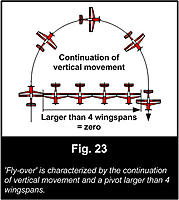|
|
|
|
|
from the rules: " One way to recognize a “fly-over” from a wind drift will be that the “fly-over” is generally characterized by the continuation of vertical movement and a pivot larger than 4 wingspans. A “fly-over” Stall Turn should be zeroed (Fig 23)."
"generally characterized" is ambiguous at best and does not provide the judge a fixed definition or deductions. that kind of language leads to inconsistency in judging - even when the judges see the same thing. in other words, there is no fixed definition of a fly over, the rules simply provide a guide that a judge may choose or not to choose to follow in determining a score. the zero that I awarded was based on the last line of the rule, which gives me the absolute right to determine that that what the pilot flew was a flyer over and thus a zero. gotta go find my meds. have a great day all... Paul |
|
|
|
|
||
|
Joined Jul 2009
744 Posts
|
Quote:
And yes, there are certified judging instructors. |
|
|
|
||
|
|
Quote:
|
|
|
|
|
|
|
wayne, the rules do not require that I consider that in my score. that's the language of the rule - there is no requirement that the flyover exceed four wingspans to be zeroed.
if I believe it was a flyover and the displacement was less than four wingspans - it's a zero. I think we agree that a flyover is the same as flying a 3 point roll where the Aresti says 4. any kind of flyover regardless of displacement is not a stall turn by definition and it's going to be zeroed. |
|
|
|
|
|
The rule book is comparing "wind-drift" and a fly-over.
Judges must be careful to deduct only for true extended turnaround, and not for any apparent deviation caused by wind drift during the pivot. One way to recognize a “fly-over” from a wind drift will be that the “fly-over” is generally characterized by the continuation of vertical movement and a pivot larger than 4 wingspans. A “fly-over” Stall Turn should be zeroed (Fig 23). |
|
|
|
|
|
wayne, the word "generally" appears in the text but not the caption. it's obvious that you are relying on the caption, which I admit I hadn't read. as these are the AMA rules, and not the IMAC rules I think it is correct to state that IMAC recognizes the discrepancy in the AMA rules but interprets the rule using the caption definition. might be wise to amend the rule in the future to exclude "generally" for no other reason than to create consistency of the language.
|
|
|
|||
|
|
Quote:
Quote:
Without the 4-span + pivot it is not a Fly-over. The "and" makes it clear that BOTH the continued vertical movement AND the 4-span displacement are require in order for it to be a Fly-over. |
||
|
|
|
|
|
Getting back to the original matter, the roll, I thought I would share my own experience as a newbie to IMAC like to OP.
When I first started practicing the roll I had trouble with the timing on the rudder and I would end up rolling out off axis every time. The intuitive thing to try and do is speed up the roll so there is less rudder correction required. It feels like rolling faster results in a more axial roll without correction, which is partially true. Problem is that it doesn't result in an axial roll, just a little less error in the end. One of the higher level competitors helped me out a lot by having me first do half rolls, slowly. After getting those to look pretty good I went to very slow rolls. Much slower than you would see people fly in contests. While the slower roll requires more rudder/elevator correction than a fast roll, it also gives you more time to see what the airplane is doing. Slow it way way down. The first several will look funny or even be complete disasters, but it will eventually come together and you can work your way up to a more typical roll rate. |
|
|
|
|
|
Taking some time with aileron differential also helps take some of the wandering out of axial rolls. Ironically enough the FAI pattern this year actually has a "Barrel Roll" in it!! Talk about going the other direction!!
|
|
|
|
|
Joined Jul 2009
744 Posts
|
My bad, never seen a wing having to go backwards in order to make a spin entry
|
|
|
||
|
|
Quote:
And to whomever was arguing about the wings level at the beginning of the roll, say that was the line before....well the level line before is either judged as the end of the last maneuver or the beginning of the next. If one exits the last maneuver wings perfectly level, but then lets one wing drop 20 degrees before beginning the next maneuver the 2 point deductions comes off for that one. Go have fun.... |
|
|
|
||
|
|
Quote:
 ) )
|
|
|
|
||
|
|
Quote:
 One other point... On the BASIC Sequence.... Since it is the first figure in the sequence, the Scale Aerobatics rule book says: 6.2: Beginning and ending of a figure. The first figure of a sequence begins at the moment the aircraft departs from its wings-level, horizontal flight path. Looking forward to seeing you at the NATS. I know I have put this up somewhere before...but BASIC pilots should review this: BASIC SEQUENCE TRAINING Wayne |
|
«
Previous Thread
|
Next Thread
»
| Currently Active Users Viewing This Thread: 1 (0 members and 1 guests) | |
| Thread Tools | |







